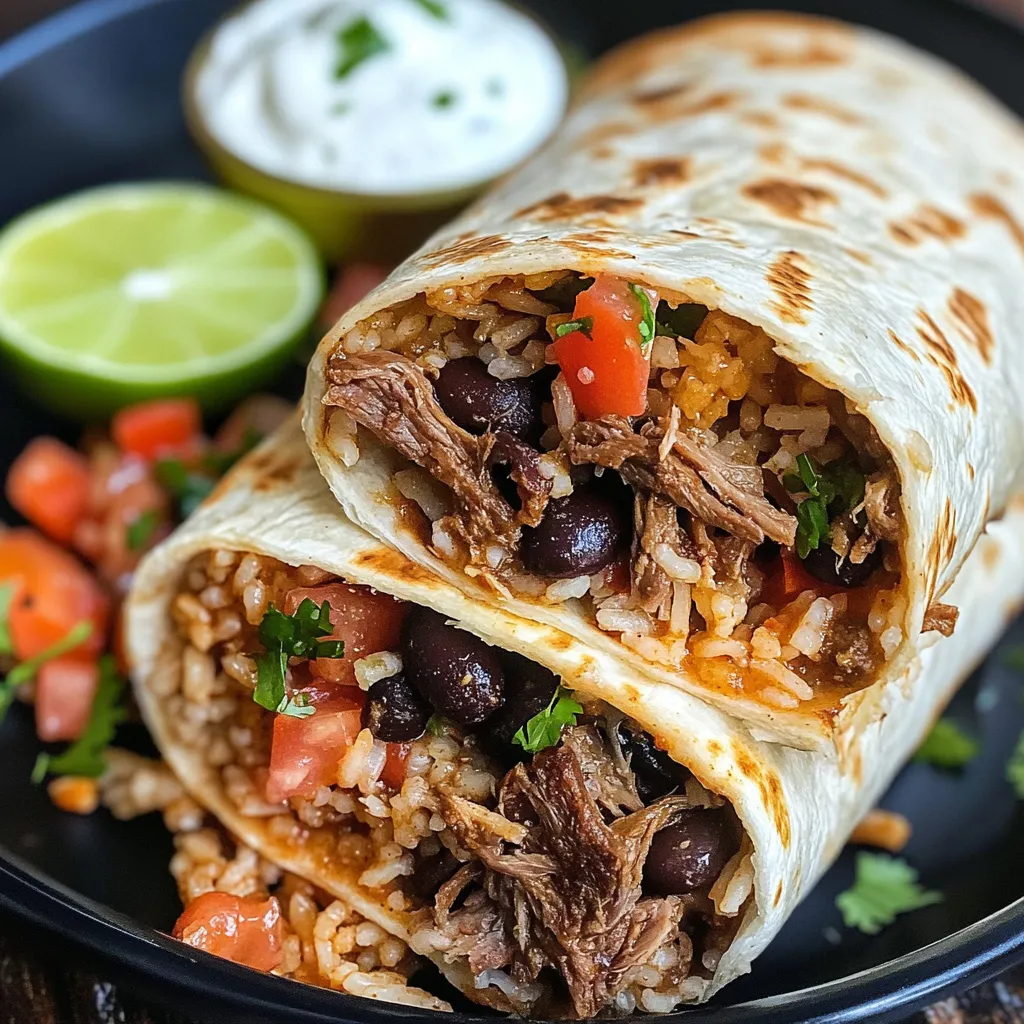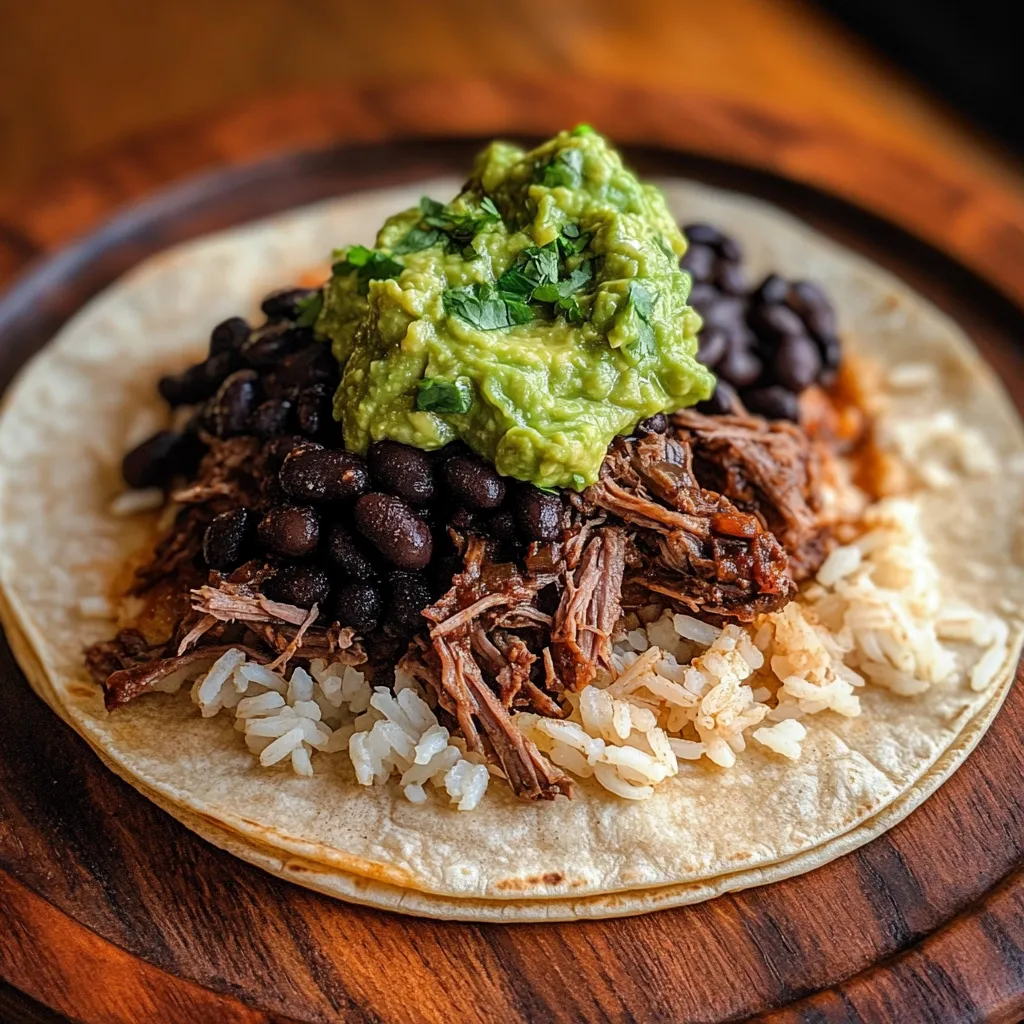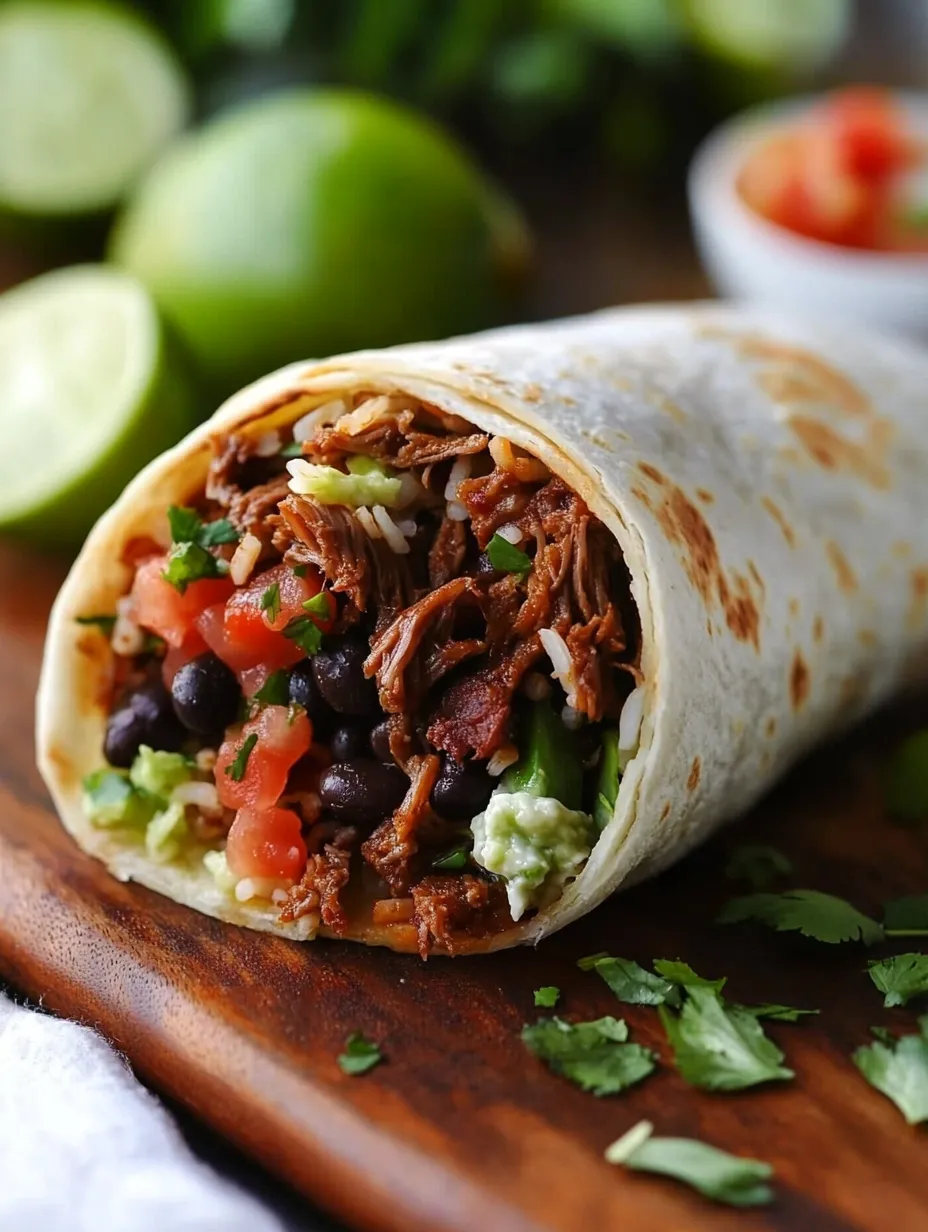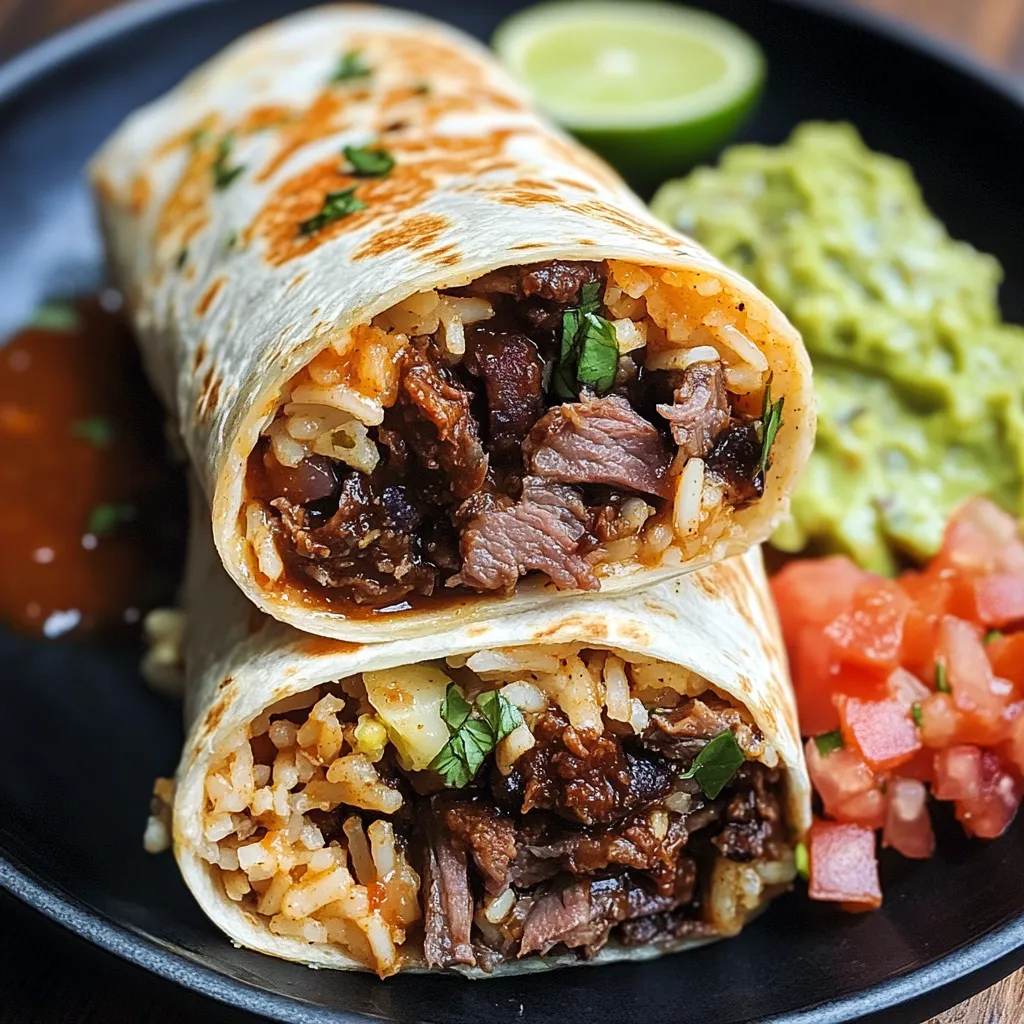 Pin
Pin
The rich aroma of slow-cooked barbacoa beef carries me back to Sunday mornings in my grandmother's kitchen. There's something magical about the way this traditional Mexican preparation transforms simple ingredients into something extraordinary. When wrapped in a warm tortilla with perfectly seasoned rice, fresh toppings, and a drizzle of sauce, it creates a burrito that's both comforting and exciting. Every bite tells a story of generations of cooking wisdom, adapted for today's kitchen.
Last week, I served these burritos at a casual gathering, and the quiet that fell over the room as everyone took their first bite said everything. Even my neighbor's teenager, who usually picks at his food, asked for the recipe. The secret lies in treating each component with care and understanding how they work together.
Essential Ingredients and Selection Tips
- Beef Chuck Roast: Choose a well-marbled piece with good fat distribution. I've found that a 3-4 pound roast gives the best results, allowing the meat to stay moist during the long cooking process. Look for bright red meat with white (not yellow) fat marbling
- Dried Chiles: A combination of chipotle and guajillo chiles creates the perfect balance of smoke and depth. Source these from Mexican markets where turnover ensures freshness. The chiles should be pliable, not brittle
- White Rice: I prefer jasmine rice for its subtle floral aroma and ability to stay fluffy even when loaded with lime and cilantro. Look for grains that are uniform in size without broken pieces
- Fresh Herbs and Aromatics: Fresh cilantro, garlic, and limes are non-negotiable. Choose bright green cilantro with perky leaves and firm limes that feel heavy for their size
The foundation of an exceptional barbacoa burrito lies in understanding how these ingredients work together. Through years of making this recipe, I've learned that each component plays a crucial role in building layers of flavor that make the final result so satisfying. Let me share the techniques I've perfected over countless Sunday family meals.
Creating Perfect Barbacoa
- Step 1:
- Toast your dried chiles in a dry skillet until they become fragrant. Soak them in hot water until completely soft, about 30 minutes.
- Step 2:
- Pat the chuck roast completely dry with paper towels. Season generously with salt and pepper, then sear in a hot Dutch oven until each side develops a rich brown crust, about 15-20 minutes.
- Step 3:
- In a blender, combine the soaked chiles, fresh garlic, cumin, oregano, apple cider vinegar, and a splash of the chile soaking liquid. Blend until smooth, then strain through a fine-mesh sieve.
- Step 4:
- Pour the sauce over the seared meat, add bay leaves, and nestle quartered onions around the edges. Cover tightly and cook low and slow for 8 hours in a slow cooker or 4 hours in a 300°F oven.

Building the Perfect Burrito
Start with your cilantro lime rice. Rinse your rice until the water runs clear, then cook it with a pinch of salt. While still hot, fluff it with a fork and add finely chopped cilantro, lime zest, and fresh lime juice. This immediate seasoning allows the rice to absorb all those bright flavors as it cools slightly.
Assembly Mastery
Lay out your warmed tortilla and start with a base layer of that fragrant cilantro-lime rice. Add your warm barbacoa, letting any extra juices drip back into the pot. Layer your black beans alongside the meat, then add cheese, guacamole, pico de gallo, and a drizzle of crema.
The Art of Temperature and Texture
Through countless burrito assemblies, I've learned that temperature layering makes a huge difference. Keep your meat and rice warm, but not hot, while your fresh toppings should be cool and crisp. This contrast creates a more interesting eating experience. I arrange my toppings in a specific order: cheese goes next to the warm ingredients so it slightly melts, followed by guacamole, pico de gallo, and finally, a drizzle of crema.
Seasonal Adaptations

Spring brings fresh tomatillos for salsa verde, summer offers ripe tomatoes for pico de gallo, fall introduces roasted corn salsa, and winter welcomes heartier toppings like pickled onions. Adapt this classic recipe to what's in season.
Creative Variations
While traditional barbacoa uses beef chuck, try brisket for a richer version or pork shoulder for a lighter alternative. Each variation offers unique insights into slow cooking and marinades.
Sauce Sophistication
Building your sauce selection takes these burritos to another level. Beyond the basic crema, consider offering a smoky chipotle sauce, tangy tomatillo salsa, and a fresh pico de gallo. I keep each sauce in squeeze bottles for easy application and beautiful presentation. Remember that sauces aren't just toppings - they're an integral part of the burrito's flavor architecture.
Make-Ahead Strategy
The beauty of barbacoa lies in how well it keeps and even improves over time. I often make a large batch on Sunday, portion it into containers with some of its cooking liquid, and enjoy it throughout the week. The flavors continue to develop, making each burrito better than the last.
Family Style Service

Setting up a burrito bar has become my favorite way to entertain. Arrange all components in a logical flow: warmed tortillas, rice, meat, beans, and then toppings. This allows guests to customize their burritos while keeping the assembly line moving smoothly. It's also a great way to accommodate different dietary preferences.
Mastering the Roll
A properly rolled burrito stays together until the last bite. Place your fillings just below the center of the tortilla, leaving an inch border on the sides. Fold the sides in first, then lift the bottom edge over the filling. Keep tension as you roll forward, tucking the contents in with your fingertips. The final roll should be snug but not so tight that it tears the tortilla.
Extended Final Thoughts
Creating the perfect barbacoa burrito is about understanding the harmony between tradition and innovation. From the braised meat to the finishing squeeze of lime, each component plays a role. Through family gatherings and countless attempts, this recipe has evolved while maintaining its soulful roots.
Personal Reflection
My journey with barbacoa began in my grandmother's kitchen, where each step had meaning. Today, I honor her legacy by preparing these burritos with care, connecting generations through shared meals.
Cultural and Historical Context
Barbacoa's origins trace back to traditional Mexican cooking methods using underground pits. Modern adaptations respect these roots while incorporating contemporary techniques, highlighting the dish's dynamic evolution.
The burrito format itself tells another story of cultural fusion, wrapping traditional barbacoa in a convenient, portable form that speaks to today's eating habits while maintaining authentic flavors. It's a perfect example of how food traditions adapt and thrive across generations and borders.
Recipe FAQs
- → Can I prepare the rice ahead of time?
- Yes, make the cilantro-lime rice in advance and reheat when assembling burritos.
- → Where can I find beef barbacoa?
- Most grocery stores sell pre-cooked barbacoa in the meat section, or you can use leftover homemade barbacoa.
- → Can I freeze these burritos?
- Yes, wrap assembled burritos in foil and freeze. Skip lettuce and fresh toppings if freezing.
- → What can I substitute for guacamole?
- Sliced avocado or your favorite salsa works well as an alternative.
- → How do I keep the tortillas from breaking?
- Warming tortillas makes them more pliable. Don't overfill, and keep them covered until ready to use.
